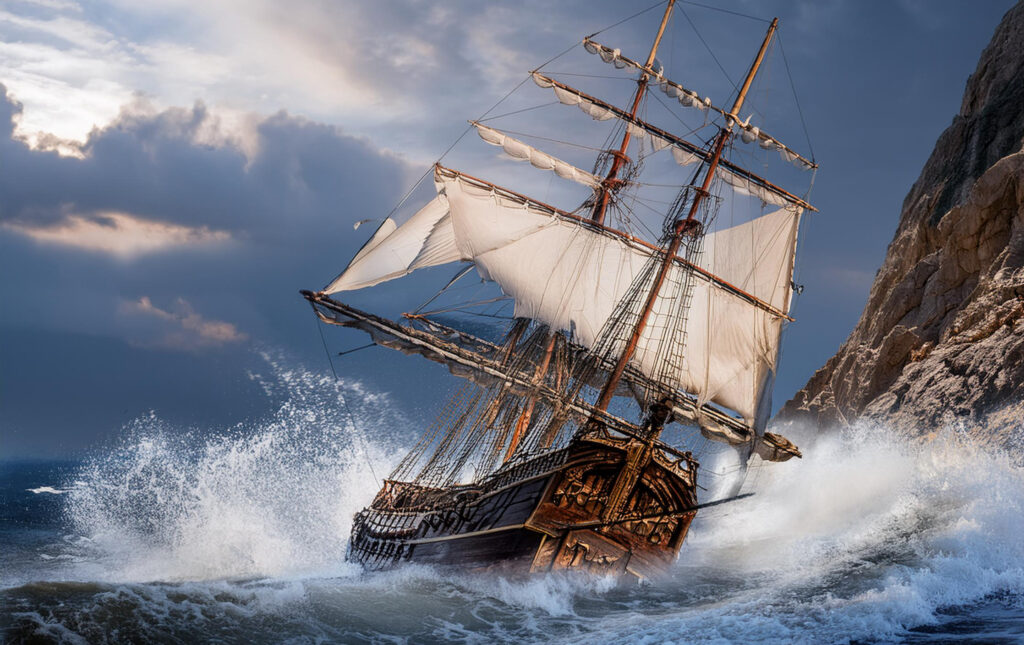We are not afraid to die Class 11 English, For Class 11 English, Chapter 2, titled “We’re Not Afraid to Die… if We Can All Be Together,” you can find the question and answer sections for each chapter in the list provided. This allows you to easily browse through the different chapters. Class 11 English Hornbill Question Answer, HS 1st year English Notes prepared by kjv teachers.
We are Not Afraid to die Class 11 English
HS 1st Year English Ch 2 Question Answers are given in this post. You’ll gain a solid understanding of the subject using the detailed solutions available here. The Class 11 English Snapshots Solutions are also available in an easy-to-read page format. Use these resources during your study sessions to help you score well in your exams. These notes are checked by K.J.V Teachers.
Question 1: List the steps taken by the captain:
1)to protect the ship when rough weather began
2)to check the flooding of the water in the ship
Answer: 1) To protect the ship when rough weather began:
To keep the ship safe during bad weather, the captain slowed it down. He put up a storm jib (a small sail) and tied a strong rope in a loop across the front of the ship. Then, they made sure everything was tightly secured and practiced their life-raft drill.
2) To check the flooding of the water in the ship:
Larry and Herb started pumping the water out. The captain put canvas over the big holes and secured waterproof covers on the hatches. When the hand pumps got blocked and the electric pump stopped working, he found another electric pump, connected it to a pipe, and started it to remove the water.
Question 2: Describe the mental condition of the voyages on 4th and 5th January.
Answer: On the 4th and 5th of January, the voyagers felt tired and worried. The bad weather and flooding made them anxious, but they kept working hard to survive. They stayed focused, even though they were scared and stressed.
Question 3: Describe the shifts in the narration of the events as indicated in the three sections of the text. Give a subtitle to each section.
Answers:
First Section: “The Calm Before the Storm”
The first part of the story describes the peaceful journey before the bad weather hit. The captain and the crew are relaxed, and everything seems fine. They talk about their plans and expectations.Second Section: “The Struggle Against the Storm”
In this section, the weather turns rough. The narration focuses on the crew’s efforts to protect the ship and handle the flooding. It shows the tension and fear as they work hard to survive.Third Section: “The Fight for Survival”
The final part describes the mental and physical exhaustion of the voyagers. The tone is more serious as the crew faces the worst part of the storm. They remain focused, but their hope starts to fade, showing the true difficulty of the situation.

We are Not Afraid to die Class 11 English
1. What difference did you notice between the reactions of the adults and the children when faced with danger?
Answer: When danger struck, the adults stayed calm and focused on what needed to be done. They worked together to protect everyone and didn’t show panic. The children, however, were scared and unsure of what to do. They relied on the adults for comfort and guidance, showing more fear and confusion than the adults.
2. How does the story suggest that optimism helps to endure “the direst stress”?
Answer: The story shows that staying positive, even in the worst situations, can help people keep going. The captain and crew stayed hopeful, even when things were tough. Their belief that they could survive helped them stay focused and keep trying, even when everything seemed hopeless.
3. What lessons do we learn from such hazardous experiences when we are face-to-face with death ?
Answer: The most important lesson that we learn from such hazardous experiences, when we are face-to-face with death, is not to lose hope under any circumstances. Life might put you in difficult situations, but if you are positive about finding a solution and overcoming the odds, you will always succeed.
4. Why do you think people undertake such adventurous expeditions in spite of the risks involved?
Answer: People are naturally curious and love adventure. The bigger the risk, the more exciting it feels to them. Adventure calls out to those who are willing to face challenges. They focus on the thrill and excitement, not the dangers. Yes, adventures can sometimes be risky and even dangerous, but the risk doesn’t stop true adventurers. The reward of success—like fame, recognition, and even wealth—motivates them to keep going.
Extra Questions
1. Describe the narrator’s boat and how did the narrator hurt himself ?
Answers: The narrator’s boat was a small, wooden one. It was not very strong, but it was enough for the journey. While trying to manage the boat in the rough sea, the narrator hurt himself by hitting his knee on a part of the boat. The injury was painful but didn’t stop him from continuing his journey.
On January 2nd, a massive explosion rocked the Wave Walker, and a gigantic wave struck the ship. The narrator was thrown overboard, and as he was battered by the waves and tossed around, he began to lose consciousness, coming to terms with the possibility of death.
2. Describe Jonathan’s bravery and how did they reach Ile Amsterdam?
Answers: Jonathan showed great bravery by staying calm and focused, even when the situation was dangerous. He didn’t give up, even though the sea was rough and the boat was damaged. He worked hard to keep the boat moving and, despite many challenges, he managed to navigate through the storm. With his determination and skill, Jonathan and the crew finally reached Ile Amsterdam safely.
Despite the ship’s extensive damage and the water flooding in, the family and crew managed to reach Ile Amsterdam. They made it to the island with minimal struggle, thanks to their perseverance and the assistance from the island’s inhabitants.
3. Explain the narrator’s efforts in finding the small island for the last time.
Answers: The narrator faced the daunting task of locating a small island in a vast ocean. With a wide expanse of 150,000 kilometers to cover, he worked tirelessly, calculating wind speeds, adjusting their course, and using the sextant to track their position. He directed the crew to head 185 degrees, hoping they would reach the island by 5 p.m. His careful navigation and persistent effort were crucial in their eventual arrival.
4. Was Suzanne seriously hurt? How was she treated?
Answers: Yes, Suzanne, who was just seven years old, was injured. Her eyes were badly swollen, and she had a deep cut on her arm. Despite her injuries, she bravely reassured her father that she was okay. She needed six minor surgeries to address blood clots in her brain, but her resilience and the medical treatment helped her recover.
5. What difficulties did they all face that night?
Answers: That night, they faced a lot of challenges. The sea was wild, and water started flooding the boat. They had to keep pumping it out, but it felt like a losing battle. The weather was horrible, and they were all exhausted from working so hard. It was a tough, scary night, with the constant fear that things might get worse, but they kept pushing through it together.
6. How did they deal with the water that had gushed into the ship?
Answer: When water rushed into the ship, the narrator quickly tried to block the big holes to stop more from coming in. The hand pump got blocked, and the electric pump stopped working. Luckily, he found another electric pump and managed to get it running. They worked nonstop, pumping water for 36 hours. In the end, they got most of the water out, with just a little left inside. It was really hard, but they didn’t give up.
7. Why did the narrator feel that it was the most beautiful island?
Answer: The narrator felt that Ile Amsterdam was the most beautiful island because it gave them hope and safety after a very scary time at sea. They had almost lost hope of surviving. After facing big waves, strong winds, and damage to the boat, reaching the island felt like a miracle. For the narrator and his family, it was a place of peace and safety, which made it look more beautiful than any place they had ever seen.
Sl. No CONTENTS
PART – I HORNBILL(PROSE)
Chapter 1 The Portrait of A Lady
Chapter 2 “We’re Not Afraid ToDie
Chapter 3 Discovering Tut: The Saga Continues
Chapter 4 Landscape of the Soul
Chapter 5 The Ailing Planet: The Green Movement’s Role
Chapter 6 The Browning Version
Chapter 7 My Impression of Assam
PART – II HORNBILL (POETRY)
Chapter 1 A Photograph
Chapter 2 The Laburnum Top
Chapter 3 The voice of the rain
Chapter 4 Childhood
Chapter 5 Father to Son
PART – III SNAPSHOTS
Chapter 1 The Summer of the Beautiful White Horse
Chapter 2 The Address
Chapter 3 Ranga’s Marriage
Chapter 4 Albert Einstein at school
Chapter 5 Mother’s Day
Chapter 6 The Ghat of the Only World
Chapter 7 Birth
Chapter 8 The Tale of Melon City



